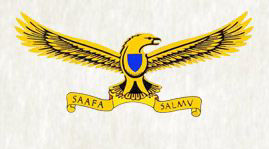

The South African Air Force was established on 1 February 1920, the second oldest in the world after the Royal Air Force. Having recommended to the British that they establish an Air force as a separate arm, it was only natural that Gen. Smuts would want to do the same for South Africa. This decision was taken in 1919 and Lt. Col. Pierre van Ryneveld was commissioned to evolve the organisation and procure the necessary equipment. Earlier that same year van Ryneveld and Major Quinton Brand had carried out their epic flight from England to the Cape, pioneering the air route down Africa.
In June 1920 van Ryneveld was appointed Director of Air Services with the temporary rank of Colonel, which was backdated to 1 February 1920, with it’s headquarters at the present SAAF College Officers Mess, Voortrekkerhoogte. This date is acknowledged as marking the official birth of the SAAF. No 1 Flight was established at Zwartkop on 26 April 1921 and it was joined by a second flight. These flights formed the nucleus of 1 Sqn which was established by early 1922. The title South African Air Force was first used officially on 1 February 1923 when the SAAF was listed under the provisions of the reconstituted SA Defence Act when it was listed as one of the corps of the Permanent Force.
When the Second World War broke out on 3 September 1939, the Commonwealth had no spare aircraft to sell and aircraft which were purchased or built in South Africa were obsolete. The SAAF consisted of a Central Flying School at Zwartkop, two light bomber squadrons which were equipped with Hartbees and based at Waterkloof, the Aircraft and Artillery Depot at Roberts Heights (Voortrekkerhoogte), and a number of detached flights operating at the out stations.
The inclusion of the entire South African Airways fleet of Junkers aircraft and the technical staff with experience in metal covered monoplanes was a boost to the SAAF, as were the civil aircraft taken over. The Junkers had been bought with a possible war in mind and the Ju-52s were used for transport and the Ju-86s as medium bombers, hastily converted for the purpose. The Ju-86s were pressed into service immediately in a maritime role and their first success was the interception of a German ship trying to run for home in December 1939.
In October 1939, Chief of the General Staff, Sir Pierre van Ryneveld, approved a plan known as the Peace Expansion Scheme, under which a total of 720 aircraft were acquired – 336 of which were fighters. When Italy entered the war in 1940, SAAF squadrons were deployed to East Africa with the aircraft available at the time, later to be supplemented by more modern aircraft. The SAAF played a tremendous part in the conquest Mussolini’s African Empire. Without air superiority, it may have taken months to move the Italians from their positions in the mountains. They were simply blasted out of their positions, impregnable from the ground, by bombs let loose upon them by the SAAF. Conditions were far from ideal, operations were from makeshift desert airfields or hacked out of bush. Then there was the tropical sun and the fine dust that got into motors, machine guns and food.
SAAF squadrons moved on to Northern Africa in april 1942, now equipped with the latest aircraft. 2 heavy bomber squadrons, 31 and 34, flying American built B-24 Liberators, were formed early in 1944. While based in Italy these squadrons, as part of 205 Group RAF, undertook 181 sorties during August and September 1944 dropping supplies to the Polish patriots in Warsaw, who were fighting desperately for their lives on the ground. Although very little was accomplished by these operations, they nevertheless represent one of the most outstanding achievements in the history of the SAAF.